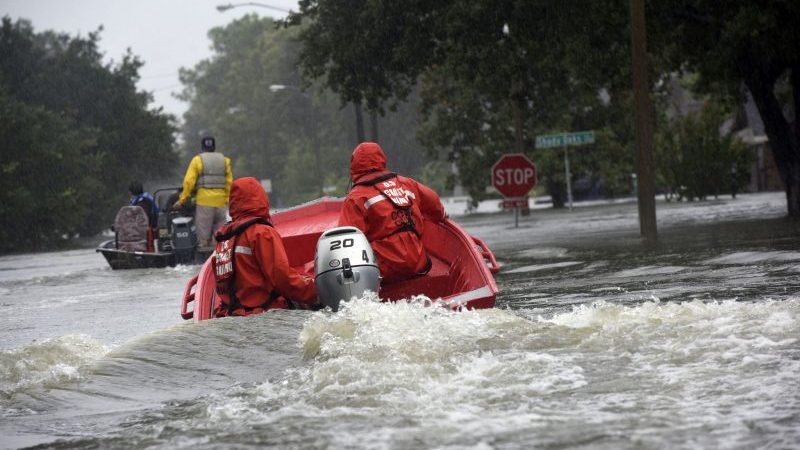A sari-clad woman wading through waist-high water. A highway turned into a river. A townscape where only the rooftops are visible in a sea of brown.
It has been quite a week for images of the destructive power of water. One to highlight vast global disparities in responsibility for and vulnerability to climate-linked disasters.
Hurricane Harvey, a category four storm that made landfall in Texas on Friday, stuck around for days to dump unprecedented volumes of rain on Houston and the surrounding area. Weather analysts had to add new colours to their maps.
Meanwhile, the latest death toll emerged from abnormally heavy monsoons across India, Bangladesh and Nepal: 1,200. Sierra Leone mourned hundreds of people killed in flooding and mudslides two weeks earlier.
In the aftermath, many asked why Harvey got so much more coverage in international media than deadlier disasters in poorer countries. It is a familiar bias that nonetheless retains the power to outrage.
Numbers of the week
$100 million – India National Disaster Management Authority budget
$15.5 billion – US Federal Emergency Management Agency budget
Just as US rescue services are better equipped with boats, SUVs and helicopters to reach people stranded by floods, so US media is better equipped to find and tell human stories. The tale of a 3-year-old found alive, clinging to her mother’s dead body, or a Mexican bakery distributing bread have more resonance than a body count of any size.
Aditi Roy Ghatak’s unmissable report from West Bengal goes some way to redress the balance.
The US response to its disaster also, it has to be said, has more salience for the rest of the world. The actions of Sierra Leone’s authorities affect the safety of Sierra Leoneans; the actions of the US affect the safety of the climate we all share.
As the world’s second biggest emitter and largest economy, the US has capacity to cut carbon and reduce the risk of global warming for everyone. Politics holds it back. Can Harvey be the catalyst for tough conversations? Not just about rebuilding Houston smarter, but limiting the threat to vulnerable communities and future generations?
Many articles have explained how global warming is very likely to have made Hurricane Harvey more destructive. The managing editor of the Houston Chronicle, for one, wrote in the Washington Post that Harvey should be the turning point in fighting climate change.
Our job today: make sure lives are saved in Houston. Our job tomorrow: understand the role that climate change has played in this tragedy.
— Bernie Sanders (@SenSanders) August 30, 2017
Early reaction from US rightwing commentators has been typically dismissive. Witness Ann Coulter’s casual rejection of decades worth of science.
I don’t believe Hurricane Harvey is God’s punishment for Houston electing a lesbian mayor. But that is more credible than “climate change.” https://t.co/K7d7mopY5Q
— Ann Coulter (@AnnCoulter) August 29, 2017
The somewhat more engaged Bret Stephens makes the case in his latest New York Times column that money – howsoever obtained – is the best defence against extreme weather.
His observation that poor countries suffer worse loss of life in comparable disasters is indisputable (again, read Aditi’s piece) but the conclusion others simply need to “follow the path of [Texas’] extraordinary economic growth”… well, tell that to a Texan who has lost their home or Indian farmer whose crop has failed again because of increasingly erratic weather.
See twitter threads from @aaronhuertes, @DoctorVive or @Agent350 for some unpicking of Stephens’ assumptions and omissions.
Scientific relation of the week
All these floods may or may not be shown, on closer study, to bear the fingerprints of climate change. Friederike Otto, a climate scientist at Oxford University, explains how she would approach the problem.
Environmental lawyers say this kind of attribution analysis, linking extreme weather events to global warming, could reshape the legal landscape. It is a potentially potent weapon for litigation against negligent authorities or reckless businesses.
Meanwhile, physical principles provide a basis to be confident global warming made Hurricane Harvey more destructive. If you learn one bit of science this week, let it be the Clausius-Clapeyron relation: for every 1C rise in temperature, the air can hold 7% more water.
Test bed
California is on the brink of passing a law aiming for 100% renewable electricity by 2045, making it the world’s biggest market for technology to integrate variable wind and solar generation.
Not everyone thinks it is the right target – nuclear advocates in particular – but energy storage start-ups are eagerly anticipating a spike in demand, reports Meredith Rutland Bauer from San Francisco.
Problem solved?
Restructuring the US state department, Rex Tillerson plans to scrap 36 special envoy positions, including for climate change and the Arctic.
Explaining the decision, he said those roles “have accomplished or outlived their original purpose”. Hmmm.
Climate conversations
Gender remains one of climate change’s great inequalities – Isabella Lovin, deputy prime minister of Sweden, and Howard Bamsey, chief executive of the Green Climate Fund
Climate adaptation cash is failing to reach the poorest. Here’s how to fix it – Saleemul Huq, ICCCAD and IIED
I was an Exxon-funded climate scientist – Katharine Hayhoe, Texas Tech University
Coal train
Your regular reminder that India is still banking on coal as its main energy source for decades to come: a nine-point government plan for boosting production.
“The reality of India’s energy sector is that around three-quarters of our power comes from coal-powered plants and this scenario will not change significantly over the coming decades,” the report says.
And finally…
Well done for reading this far. For a bit of light relief, enjoy this smiling pig rescued from floods, which has gone viral on Chinese social media.

The “smiling pig” became a meme on Chinese social media (Pic: Weibo)
